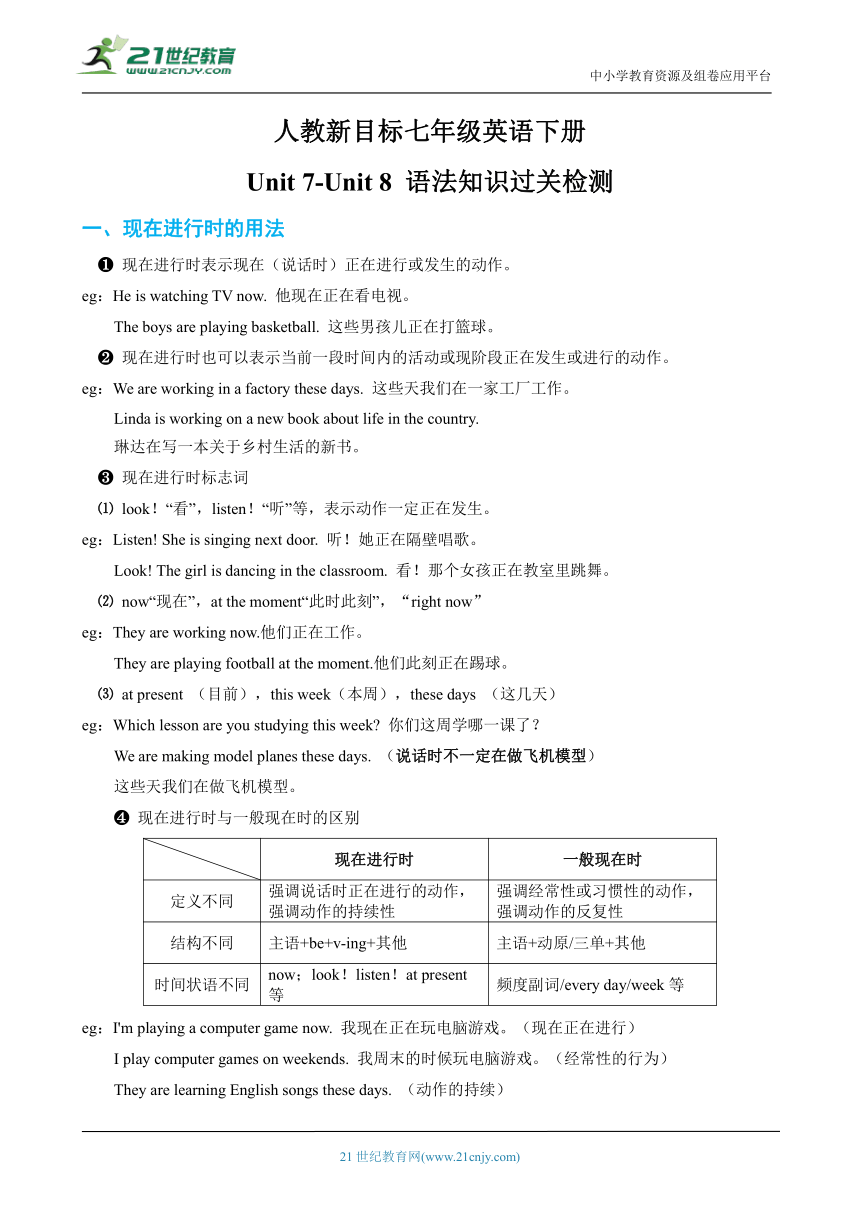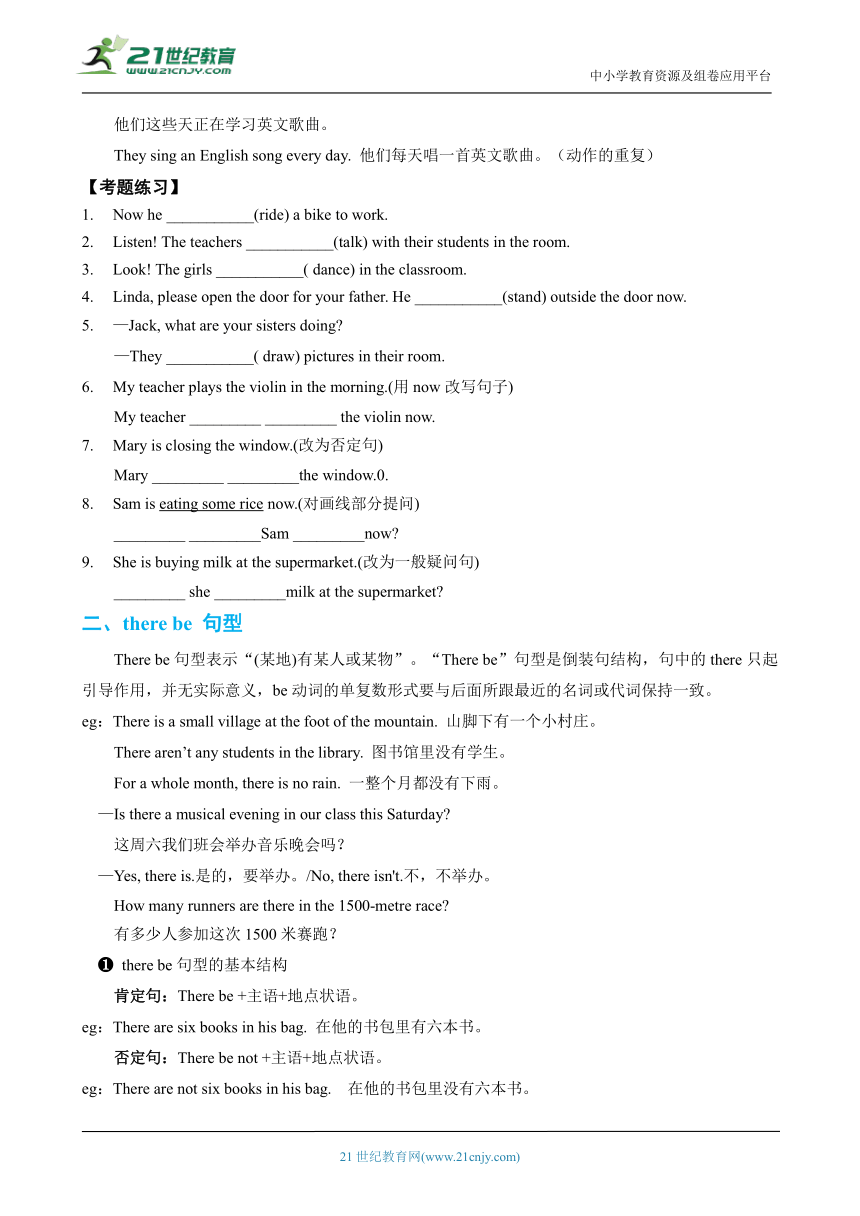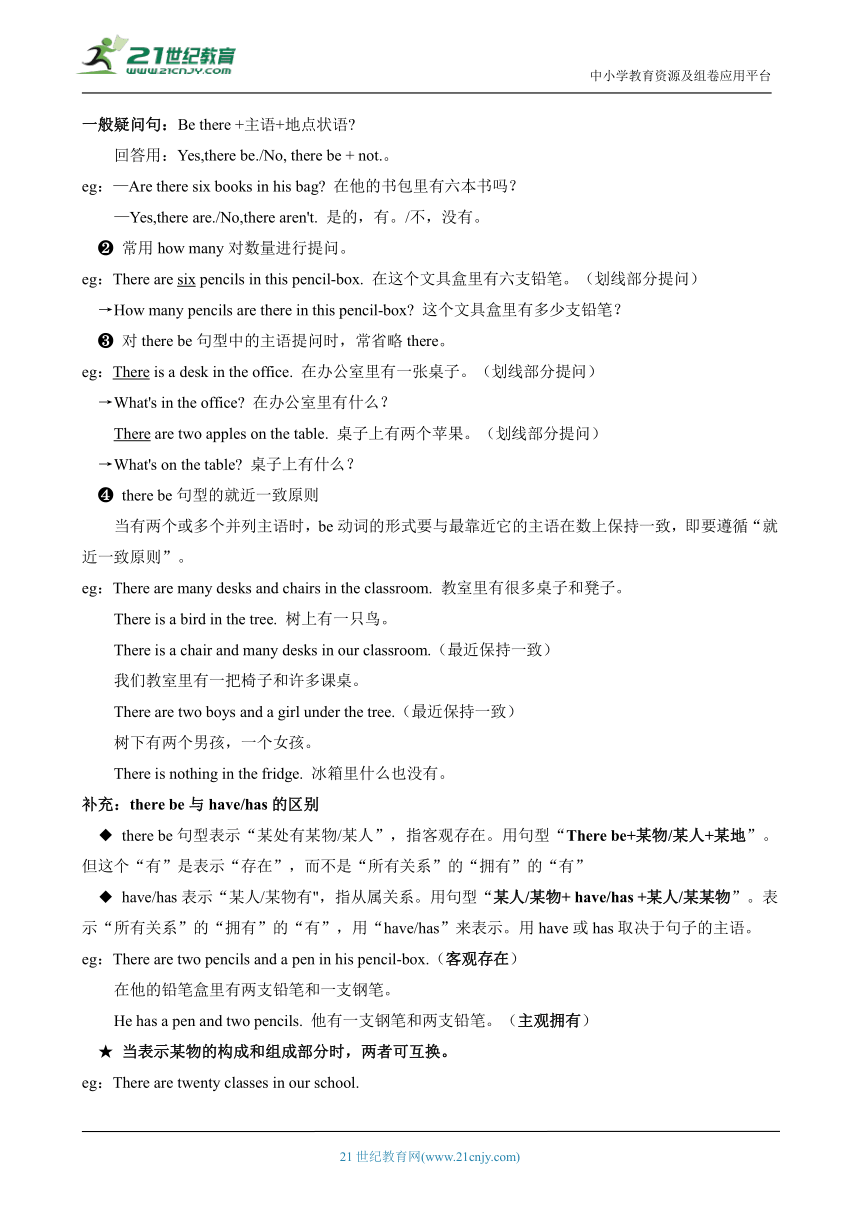【暑假作业】人教新目标七年级英语下册 Unit 7-Unit 8 语法知识过关检测now. com
文档属性
| 名称 | 【暑假作业】人教新目标七年级英语下册 Unit 7-Unit 8 语法知识过关检测now. com |  | |
| 格式 | docx | ||
| 文件大小 | 894.4KB | ||
| 资源类型 | 试卷 | ||
| 版本资源 | 人教新目标(Go for it)版 | ||
| 科目 | 英语 | ||
| 更新时间 | 2022-06-30 15:43:42 | ||
图片预览




文档简介
中小学教育资源及组卷应用平台
人教新目标七年级英语下册
Unit 7-Unit 8 语法知识过关检测
一、现在进行时的用法
现在进行时表示现在(说话时)正在进行或发生的动作。
eg:He is watching TV now. 他现在正在看电视。
The boys are playing basketball. 这些男孩儿正在打篮球。
现在进行时也可以表示当前一段时间内的活动或现阶段正在发生或进行的动作。
eg:We are working in a factory these days. 这些天我们在一家工厂工作。
Linda is working on a new book about life in the country.
琳达在写一本关于乡村生活的新书。
现在进行时标志词
⑴ look!“看”,listen!“听”等,表示动作一定正在发生。
eg:Listen! She is singing next door. 听!她正在隔壁唱歌。
Look! The girl is dancing in the classroom. 看!那个女孩正在教室里跳舞。
⑵ now“现在”,at the moment“此时此刻”,“right now”
eg:They are working now.他们正在工作。
They are playing football at the moment.他们此刻正在踢球。
⑶ at present (目前),this week(本周),these days (这几天)
eg:Which lesson are you studying this week 你们这周学哪一课了?
We are making model planes these days. (说话时不一定在做飞机模型)
这些天我们在做飞机模型。
现在进行时与一般现在时的区别
现在进行时 一般现在时
定义不同 强调说话时正在进行的动作,强调动作的持续性 强调经常性或习惯性的动作,强调动作的反复性
结构不同 主语+be+v-ing+其他 主语+动原/三单+其他
时间状语不同 now;look!listen!at present等 频度副词/every day/week等
eg:I'm playing a computer game now. 我现在正在玩电脑游戏。(现在正在进行)
I play computer games on weekends. 我周末的时候玩电脑游戏。(经常性的行为)
They are learning English songs these days. (动作的持续)
他们这些天正在学习英文歌曲。
They sing an English song every day. 他们每天唱一首英文歌曲。(动作的重复)
【考题练习】
Now he ___________(ride) a bike to work.
Listen! The teachers ___________(talk) with their students in the room.
Look! The girls ___________( dance) in the classroom.
Linda, please open the door for your father. He ___________(stand) outside the door now.
—Jack, what are your sisters doing
—They ___________( draw) pictures in their room.
My teacher plays the violin in the morning.(用now改写句子)
My teacher _________ _________ the violin now.
Mary is closing the window.(改为否定句)
Mary _________ _________the window.0.
Sam is eating some rice now.(对画线部分提问)
_________ _________Sam _________now
She is buying milk at the supermarket.(改为一般疑问句)
_________ she _________milk at the supermarket
二、there be 句型
There be句型表示“(某地)有某人或某物”。“There be”句型是倒装句结构,句中的there只起引导作用,并无实际意义,be动词的单复数形式要与后面所跟最近的名词或代词保持一致。
eg:There is a small village at the foot of the mountain. 山脚下有一个小村庄。
There aren’t any students in the library. 图书馆里没有学生。
For a whole month, there is no rain. 一整个月都没有下雨。
—Is there a musical evening in our class this Saturday
这周六我们班会举办音乐晚会吗?
—Yes, there is.是的,要举办。/No, there isn't.不,不举办。
How many runners are there in the 1500-metre race
有多少人参加这次1500米赛跑?
there be句型的基本结构
肯定句:There be +主语+地点状语。
eg:There are six books in his bag. 在他的书包里有六本书。
否定句:There be not +主语+地点状语。
eg:There are not six books in his bag. 在他的书包里没有六本书。
一般疑问句:Be there +主语+地点状语
回答用:Yes,there be./No, there be + not.。
eg:—Are there six books in his bag 在他的书包里有六本书吗?
—Yes,there are./No,there aren't. 是的,有。/不,没有。
常用how many对数量进行提问。
eg:There are six pencils in this pencil-box. 在这个文具盒里有六支铅笔。(划线部分提问)
→How many pencils are there in this pencil-box 这个文具盒里有多少支铅笔?
对there be句型中的主语提问时,常省略there。
eg:There is a desk in the office. 在办公室里有一张桌子。(划线部分提问)
→What's in the office 在办公室里有什么?
There are two apples on the table. 桌子上有两个苹果。(划线部分提问)
→What's on the table 桌子上有什么?
there be句型的就近一致原则
当有两个或多个并列主语时,be动词的形式要与最靠近它的主语在数上保持一致,即要遵循“就近一致原则”。
eg:There are many desks and chairs in the classroom. 教室里有很多桌子和凳子。
There is a bird in the tree. 树上有一只鸟。
There is a chair and many desks in our classroom.(最近保持一致)
我们教室里有一把椅子和许多课桌。
There are two boys and a girl under the tree.(最近保持一致)
树下有两个男孩,一个女孩。
There is nothing in the fridge. 冰箱里什么也没有。
补充:there be与have/has的区别
◆ there be句型表示“某处有某物/某人”,指客观存在。用句型“There be+某物/某人+某地”。但这个“有”是表示“存在”,而不是“所有关系”的“拥有”的“有”
◆ have/has表示“某人/某物有",指从属关系。用句型“某人/某物+ have/has +某人/某某物”。表示“所有关系”的“拥有”的“有”,用“have/has”来表示。用have或has取决于句子的主语。
eg:There are two pencils and a pen in his pencil-box.(客观存在)
在他的铅笔盒里有两支铅笔和一支钢笔。
He has a pen and two pencils. 他有一支钢笔和两支铅笔。(主观拥有)
★ 当表示某物的构成和组成部分时,两者可互换。
eg:There are twenty classes in our school.
=Our school has twenty classes. 我们学校有20个班级。
【考题练习】
Ⅰ、用“There be”的正确形式填空。
_______________ some flowers on the desk.
_______________ some tea in the cup.
_______________ some meat, some bread and some apples on the table.
_______________ a basketball match in our school yesterday.
_______________ any letters in the mailbox today.
_______________ a picture on the wall.
_______________ any milk in the fridge.
Ⅱ、根据所给汉语完成句子。
桌子上有一本书和两支钢笔。 There ________ a book and two pens on the desk.
钱包里有些钱。 There _______ some money in the picture.
在吉姆的书包里有一些卡片。 _______ _______ some cards in Jim’s bag.
里面还有其他的东西吗? _______ _______ anything else in it
我们学校有许多班。 There _______ many _______ in our school.
树上没有鸟。 There _______ _______ birds in the tree.
Ⅲ、选择填空。
-Are there any maps on the wall -_______
A. There are some B. Yes, there is.
C. Yes, there is one. D. No, there are.
How many ________ are there in the picture
A. woman B. women C. boy D. milk
There aren’t ________ trees near the house. There is only one.
A. any B. some C. many D. much
There ________ two bowls of rice on the table.
A. is B. have C. has D. are
Are there ________ houses near the river Yes, there are ________ .
A. some, some B. any, some
C. any, any D. some, any
Ⅳ、用所给单词的适当形式填空。
-How many ________ (bus) ________ (be) there in the street
-There ________ (be) one.
________ (be)there any bread in the kitchen
-________ (be) there any water in the glass
-No, there ________ (not be).
-How many ________ (mango芒果) are there on the plate
-There ________ (be) three.
There ________ (be) some water in the glass.
________ (there be )some books and a pencil-box in the desk.
________ (there be )a pencil-box and some books in the desk.
How many ________ (flower) are there in the garden
There aren’t ________ (some) ________ (child) in the park.
Are there ________(some)books on the desk?
五、句型转换
There is a woman near the house.(改为否定句)
_________________________________________________________________
There are many books on the desk.(改为否定句)
_________________________________________________________________
There are some flowers and a desk in the room.(改为一般疑问句)
_________________________________________________________________
There are many books on the desk.(改为一般疑问句)
_________________________________________________________________
There is a woman near the house.(对划线部分提问)
_________________________________________________________________
There are many books on the desk.(对划线部分提问)
_________________________________________________________________
There are some girls in the room.(改为一般疑问句,并作肯定和否定回答)
_________________________________________________________________
Are there any books in the reading room.(作肯定和否定回答)
_________________________________________________________________
There are six boys in the classroom.(对划线部分提问)
_________________________________________________________________
三、problem与question
problem problem多指客观存在的“困难,问题”,通常也指要解决或决定的问题,尤其指比较困难的问题、社会问题,强调困难。表示待解决的问题,常与动词solve搭配。solve the problem“解决问题”
question question常指由于对某事感到疑惑不解而提出需要解答的“问题”,强调疑惑不解,常与ask和answer连用。answer the question“回答问题”
eg:Did they solve the problem 她们解决问题了吗?
—Can you help me with my English after school 放学后你能帮我学习英语吗?
—No problem. 没问题。
You may tell me what the problem is. 你可以告诉我问题是什么。
Can I ask you a question 我能问你一个问题吗?
What's the matter with you 你怎么啦?
【考题练习】
这个问题很难解决。
The ___________ is difficult to be solved.
我可以问你一些问题吗?
May I ask you some _____________
问题是如何为工程筹集资金。
The ___________ is how to get the money for the project.
现在仔细听我说并且回答我的问题。
Now listen to me carefully and answer my ____________.
这道数学题太难了,我不能把它算出来。
The maths __________ is too difficult. I can't work it out.
四、across from与cross的用法
across介词,意为“过;穿过”,着重指从物体的表面“通过”,常和动词搭配使用。across from 意为“在……对面”。
cross用作名词时的意思是“十字形”,转化为动词后可表示“画十字,划叉删去”,还可表示“交叉”“横穿,跨越”。引申可表示“反对,阻挠”。cross既可用作不及物动词,也可用作及物动词。用作及物动词时,接名词或代词作宾语。crossing名词,意为“十字路口”。
eg:The pay phone is across from the library. 公用电话在图书馆对面。
The shop is across from the park. 商店在公园的对面。
There is a school just across from our house. 有一所学校就在我们家对面。
The two railways cross here. 这两条铁路在这里交叉。
Turn right at the first crossing and the restaurant is on your left.
在第一十字路口右转,餐馆就在你的左边
【考题练习】
Let’s __________ the road now.
They live just __________ from the road.
Turn left at the first __________.
We must be careful when we __________ the road.
We must __________ the road very carefully.
Before going __________ the road, you should look left first and then right.
Look! The man is swimming __________ the lake.
__________ the street and you can get to the hotel.
五、in front of与in the front of
in front of 指“在……前面”,在某一空间外部的前面,反义词是behind。in the front of指“在……前面”,在某一空间内部的前面,反义词是at the back of。
eg:There are some trees in front of the house. 房子前面有一些树
He sat in the front of the car. 他坐在车的前面。
There are some trees behind the house. 房子后面有一些树。
He sat at the back of the car. 他坐在车的后面。
The pay phone is in front of the library. 付费电话在图书馆的前面。
Betty is standing in front of the car. 贝蒂站在小汽车的前面。
Lisa is sitting in the front of the car. 莉萨坐在小汽车的前面。
【考题练习】
There are some trees _________________ the house.
He sat _________________ the car.
The pay phone is _________________ the library.
Lisa is sitting _________________ the car.
参 考 答 案
is riding are riding are dancing
is standing are drawing is playing
isn’t closing What is;doing Is;buying
There are There is There is
There is There aren’t There is
There isn’t is are
There are Is there are;classes
are no/aren’t any C B
A D B
buses;are / is Is Is;isn’t
mangoes ;are is There are
There is flowers any ; children
any There isn’t a woman near the house.
There aren’t many books on the desk.
Are there any flowers and a desk in the room.
Are there many books on the desk.
Who is there near the house?
How many books are there on the desk?
Are there any girls in the room? Yes, there are./No, there aren’t
Yes, there are./No, there aren’t
Where are six boys?
problem questions problem
questions problem cross
across crossing cross
cross across across
Cross in front of in the front of
in front of in the front of
21世纪教育网 www.21cnjy.com 精品试卷·第 2 页 (共 2 页)
21世纪教育网(www.21cnjy.com)
人教新目标七年级英语下册
Unit 7-Unit 8 语法知识过关检测
一、现在进行时的用法
现在进行时表示现在(说话时)正在进行或发生的动作。
eg:He is watching TV now. 他现在正在看电视。
The boys are playing basketball. 这些男孩儿正在打篮球。
现在进行时也可以表示当前一段时间内的活动或现阶段正在发生或进行的动作。
eg:We are working in a factory these days. 这些天我们在一家工厂工作。
Linda is working on a new book about life in the country.
琳达在写一本关于乡村生活的新书。
现在进行时标志词
⑴ look!“看”,listen!“听”等,表示动作一定正在发生。
eg:Listen! She is singing next door. 听!她正在隔壁唱歌。
Look! The girl is dancing in the classroom. 看!那个女孩正在教室里跳舞。
⑵ now“现在”,at the moment“此时此刻”,“right now”
eg:They are working now.他们正在工作。
They are playing football at the moment.他们此刻正在踢球。
⑶ at present (目前),this week(本周),these days (这几天)
eg:Which lesson are you studying this week 你们这周学哪一课了?
We are making model planes these days. (说话时不一定在做飞机模型)
这些天我们在做飞机模型。
现在进行时与一般现在时的区别
现在进行时 一般现在时
定义不同 强调说话时正在进行的动作,强调动作的持续性 强调经常性或习惯性的动作,强调动作的反复性
结构不同 主语+be+v-ing+其他 主语+动原/三单+其他
时间状语不同 now;look!listen!at present等 频度副词/every day/week等
eg:I'm playing a computer game now. 我现在正在玩电脑游戏。(现在正在进行)
I play computer games on weekends. 我周末的时候玩电脑游戏。(经常性的行为)
They are learning English songs these days. (动作的持续)
他们这些天正在学习英文歌曲。
They sing an English song every day. 他们每天唱一首英文歌曲。(动作的重复)
【考题练习】
Now he ___________(ride) a bike to work.
Listen! The teachers ___________(talk) with their students in the room.
Look! The girls ___________( dance) in the classroom.
Linda, please open the door for your father. He ___________(stand) outside the door now.
—Jack, what are your sisters doing
—They ___________( draw) pictures in their room.
My teacher plays the violin in the morning.(用now改写句子)
My teacher _________ _________ the violin now.
Mary is closing the window.(改为否定句)
Mary _________ _________the window.0.
Sam is eating some rice now.(对画线部分提问)
_________ _________Sam _________now
She is buying milk at the supermarket.(改为一般疑问句)
_________ she _________milk at the supermarket
二、there be 句型
There be句型表示“(某地)有某人或某物”。“There be”句型是倒装句结构,句中的there只起引导作用,并无实际意义,be动词的单复数形式要与后面所跟最近的名词或代词保持一致。
eg:There is a small village at the foot of the mountain. 山脚下有一个小村庄。
There aren’t any students in the library. 图书馆里没有学生。
For a whole month, there is no rain. 一整个月都没有下雨。
—Is there a musical evening in our class this Saturday
这周六我们班会举办音乐晚会吗?
—Yes, there is.是的,要举办。/No, there isn't.不,不举办。
How many runners are there in the 1500-metre race
有多少人参加这次1500米赛跑?
there be句型的基本结构
肯定句:There be +主语+地点状语。
eg:There are six books in his bag. 在他的书包里有六本书。
否定句:There be not +主语+地点状语。
eg:There are not six books in his bag. 在他的书包里没有六本书。
一般疑问句:Be there +主语+地点状语
回答用:Yes,there be./No, there be + not.。
eg:—Are there six books in his bag 在他的书包里有六本书吗?
—Yes,there are./No,there aren't. 是的,有。/不,没有。
常用how many对数量进行提问。
eg:There are six pencils in this pencil-box. 在这个文具盒里有六支铅笔。(划线部分提问)
→How many pencils are there in this pencil-box 这个文具盒里有多少支铅笔?
对there be句型中的主语提问时,常省略there。
eg:There is a desk in the office. 在办公室里有一张桌子。(划线部分提问)
→What's in the office 在办公室里有什么?
There are two apples on the table. 桌子上有两个苹果。(划线部分提问)
→What's on the table 桌子上有什么?
there be句型的就近一致原则
当有两个或多个并列主语时,be动词的形式要与最靠近它的主语在数上保持一致,即要遵循“就近一致原则”。
eg:There are many desks and chairs in the classroom. 教室里有很多桌子和凳子。
There is a bird in the tree. 树上有一只鸟。
There is a chair and many desks in our classroom.(最近保持一致)
我们教室里有一把椅子和许多课桌。
There are two boys and a girl under the tree.(最近保持一致)
树下有两个男孩,一个女孩。
There is nothing in the fridge. 冰箱里什么也没有。
补充:there be与have/has的区别
◆ there be句型表示“某处有某物/某人”,指客观存在。用句型“There be+某物/某人+某地”。但这个“有”是表示“存在”,而不是“所有关系”的“拥有”的“有”
◆ have/has表示“某人/某物有",指从属关系。用句型“某人/某物+ have/has +某人/某某物”。表示“所有关系”的“拥有”的“有”,用“have/has”来表示。用have或has取决于句子的主语。
eg:There are two pencils and a pen in his pencil-box.(客观存在)
在他的铅笔盒里有两支铅笔和一支钢笔。
He has a pen and two pencils. 他有一支钢笔和两支铅笔。(主观拥有)
★ 当表示某物的构成和组成部分时,两者可互换。
eg:There are twenty classes in our school.
=Our school has twenty classes. 我们学校有20个班级。
【考题练习】
Ⅰ、用“There be”的正确形式填空。
_______________ some flowers on the desk.
_______________ some tea in the cup.
_______________ some meat, some bread and some apples on the table.
_______________ a basketball match in our school yesterday.
_______________ any letters in the mailbox today.
_______________ a picture on the wall.
_______________ any milk in the fridge.
Ⅱ、根据所给汉语完成句子。
桌子上有一本书和两支钢笔。 There ________ a book and two pens on the desk.
钱包里有些钱。 There _______ some money in the picture.
在吉姆的书包里有一些卡片。 _______ _______ some cards in Jim’s bag.
里面还有其他的东西吗? _______ _______ anything else in it
我们学校有许多班。 There _______ many _______ in our school.
树上没有鸟。 There _______ _______ birds in the tree.
Ⅲ、选择填空。
-Are there any maps on the wall -_______
A. There are some B. Yes, there is.
C. Yes, there is one. D. No, there are.
How many ________ are there in the picture
A. woman B. women C. boy D. milk
There aren’t ________ trees near the house. There is only one.
A. any B. some C. many D. much
There ________ two bowls of rice on the table.
A. is B. have C. has D. are
Are there ________ houses near the river Yes, there are ________ .
A. some, some B. any, some
C. any, any D. some, any
Ⅳ、用所给单词的适当形式填空。
-How many ________ (bus) ________ (be) there in the street
-There ________ (be) one.
________ (be)there any bread in the kitchen
-________ (be) there any water in the glass
-No, there ________ (not be).
-How many ________ (mango芒果) are there on the plate
-There ________ (be) three.
There ________ (be) some water in the glass.
________ (there be )some books and a pencil-box in the desk.
________ (there be )a pencil-box and some books in the desk.
How many ________ (flower) are there in the garden
There aren’t ________ (some) ________ (child) in the park.
Are there ________(some)books on the desk?
五、句型转换
There is a woman near the house.(改为否定句)
_________________________________________________________________
There are many books on the desk.(改为否定句)
_________________________________________________________________
There are some flowers and a desk in the room.(改为一般疑问句)
_________________________________________________________________
There are many books on the desk.(改为一般疑问句)
_________________________________________________________________
There is a woman near the house.(对划线部分提问)
_________________________________________________________________
There are many books on the desk.(对划线部分提问)
_________________________________________________________________
There are some girls in the room.(改为一般疑问句,并作肯定和否定回答)
_________________________________________________________________
Are there any books in the reading room.(作肯定和否定回答)
_________________________________________________________________
There are six boys in the classroom.(对划线部分提问)
_________________________________________________________________
三、problem与question
problem problem多指客观存在的“困难,问题”,通常也指要解决或决定的问题,尤其指比较困难的问题、社会问题,强调困难。表示待解决的问题,常与动词solve搭配。solve the problem“解决问题”
question question常指由于对某事感到疑惑不解而提出需要解答的“问题”,强调疑惑不解,常与ask和answer连用。answer the question“回答问题”
eg:Did they solve the problem 她们解决问题了吗?
—Can you help me with my English after school 放学后你能帮我学习英语吗?
—No problem. 没问题。
You may tell me what the problem is. 你可以告诉我问题是什么。
Can I ask you a question 我能问你一个问题吗?
What's the matter with you 你怎么啦?
【考题练习】
这个问题很难解决。
The ___________ is difficult to be solved.
我可以问你一些问题吗?
May I ask you some _____________
问题是如何为工程筹集资金。
The ___________ is how to get the money for the project.
现在仔细听我说并且回答我的问题。
Now listen to me carefully and answer my ____________.
这道数学题太难了,我不能把它算出来。
The maths __________ is too difficult. I can't work it out.
四、across from与cross的用法
across介词,意为“过;穿过”,着重指从物体的表面“通过”,常和动词搭配使用。across from 意为“在……对面”。
cross用作名词时的意思是“十字形”,转化为动词后可表示“画十字,划叉删去”,还可表示“交叉”“横穿,跨越”。引申可表示“反对,阻挠”。cross既可用作不及物动词,也可用作及物动词。用作及物动词时,接名词或代词作宾语。crossing名词,意为“十字路口”。
eg:The pay phone is across from the library. 公用电话在图书馆对面。
The shop is across from the park. 商店在公园的对面。
There is a school just across from our house. 有一所学校就在我们家对面。
The two railways cross here. 这两条铁路在这里交叉。
Turn right at the first crossing and the restaurant is on your left.
在第一十字路口右转,餐馆就在你的左边
【考题练习】
Let’s __________ the road now.
They live just __________ from the road.
Turn left at the first __________.
We must be careful when we __________ the road.
We must __________ the road very carefully.
Before going __________ the road, you should look left first and then right.
Look! The man is swimming __________ the lake.
__________ the street and you can get to the hotel.
五、in front of与in the front of
in front of 指“在……前面”,在某一空间外部的前面,反义词是behind。in the front of指“在……前面”,在某一空间内部的前面,反义词是at the back of。
eg:There are some trees in front of the house. 房子前面有一些树
He sat in the front of the car. 他坐在车的前面。
There are some trees behind the house. 房子后面有一些树。
He sat at the back of the car. 他坐在车的后面。
The pay phone is in front of the library. 付费电话在图书馆的前面。
Betty is standing in front of the car. 贝蒂站在小汽车的前面。
Lisa is sitting in the front of the car. 莉萨坐在小汽车的前面。
【考题练习】
There are some trees _________________ the house.
He sat _________________ the car.
The pay phone is _________________ the library.
Lisa is sitting _________________ the car.
参 考 答 案
is riding are riding are dancing
is standing are drawing is playing
isn’t closing What is;doing Is;buying
There are There is There is
There is There aren’t There is
There isn’t is are
There are Is there are;classes
are no/aren’t any C B
A D B
buses;are / is Is Is;isn’t
mangoes ;are is There are
There is flowers any ; children
any There isn’t a woman near the house.
There aren’t many books on the desk.
Are there any flowers and a desk in the room.
Are there many books on the desk.
Who is there near the house?
How many books are there on the desk?
Are there any girls in the room? Yes, there are./No, there aren’t
Yes, there are./No, there aren’t
Where are six boys?
problem questions problem
questions problem cross
across crossing cross
cross across across
Cross in front of in the front of
in front of in the front of
21世纪教育网 www.21cnjy.com 精品试卷·第 2 页 (共 2 页)
21世纪教育网(www.21cnjy.com)
同课章节目录
